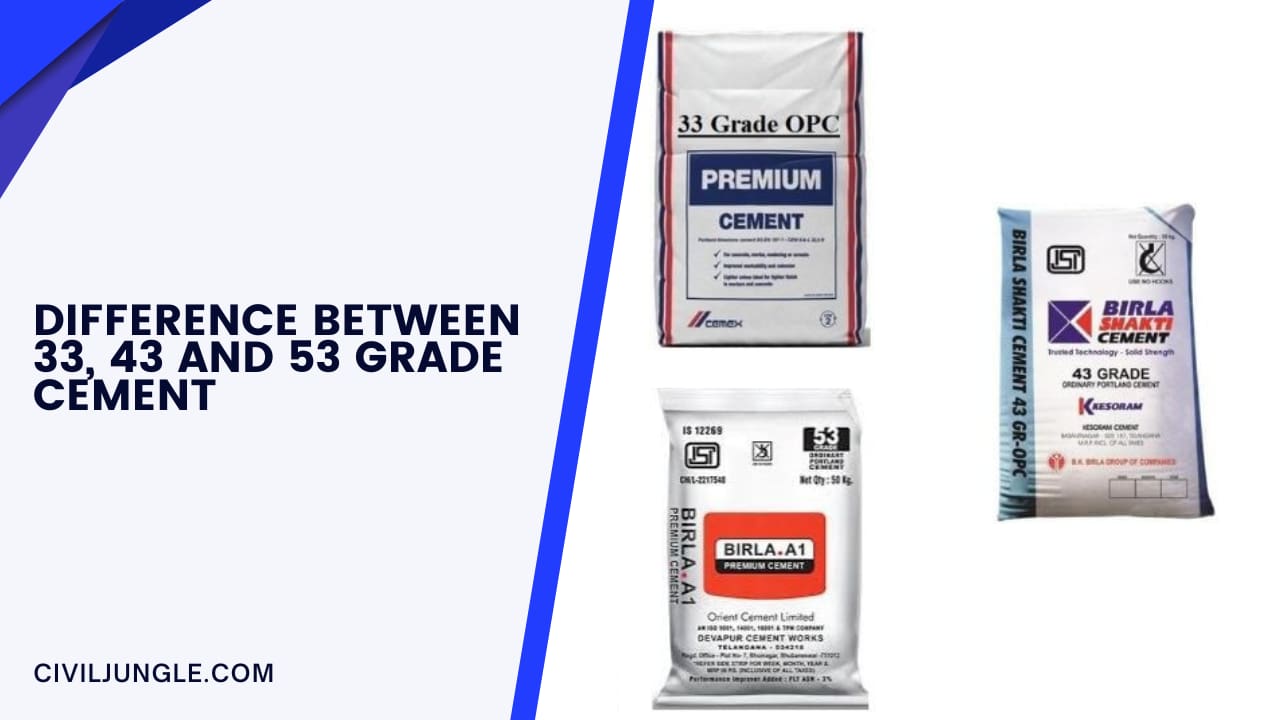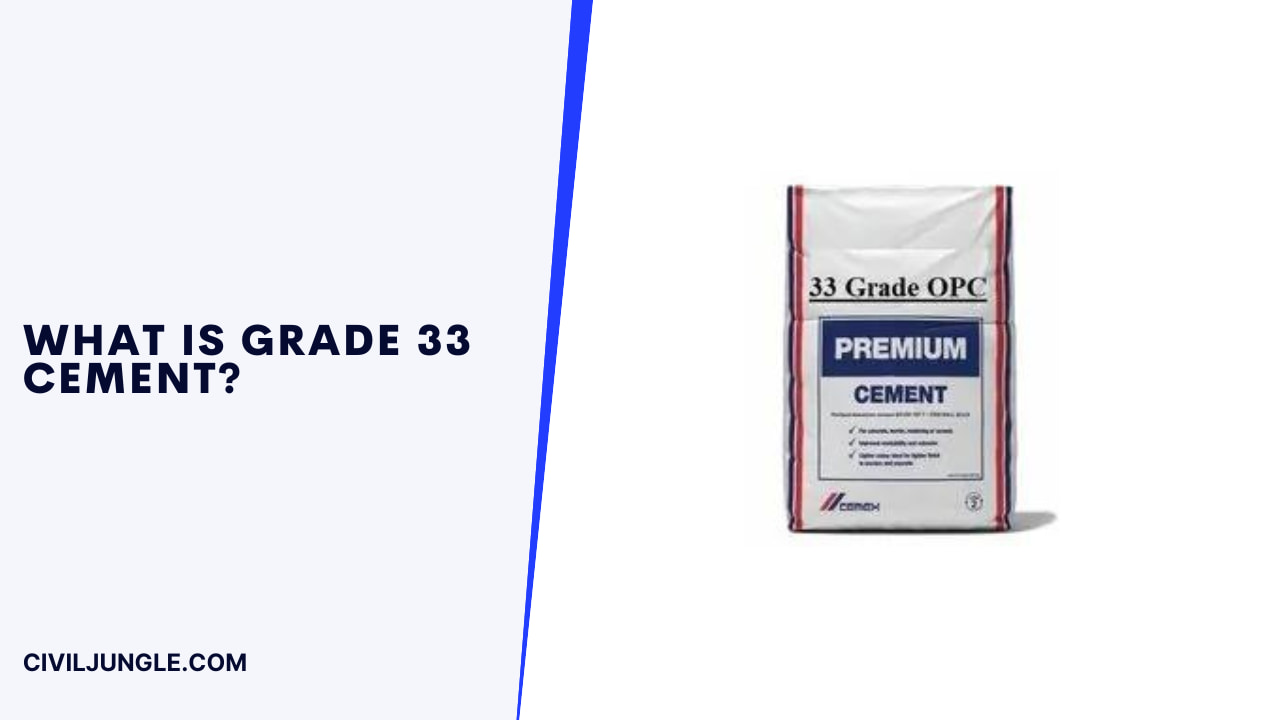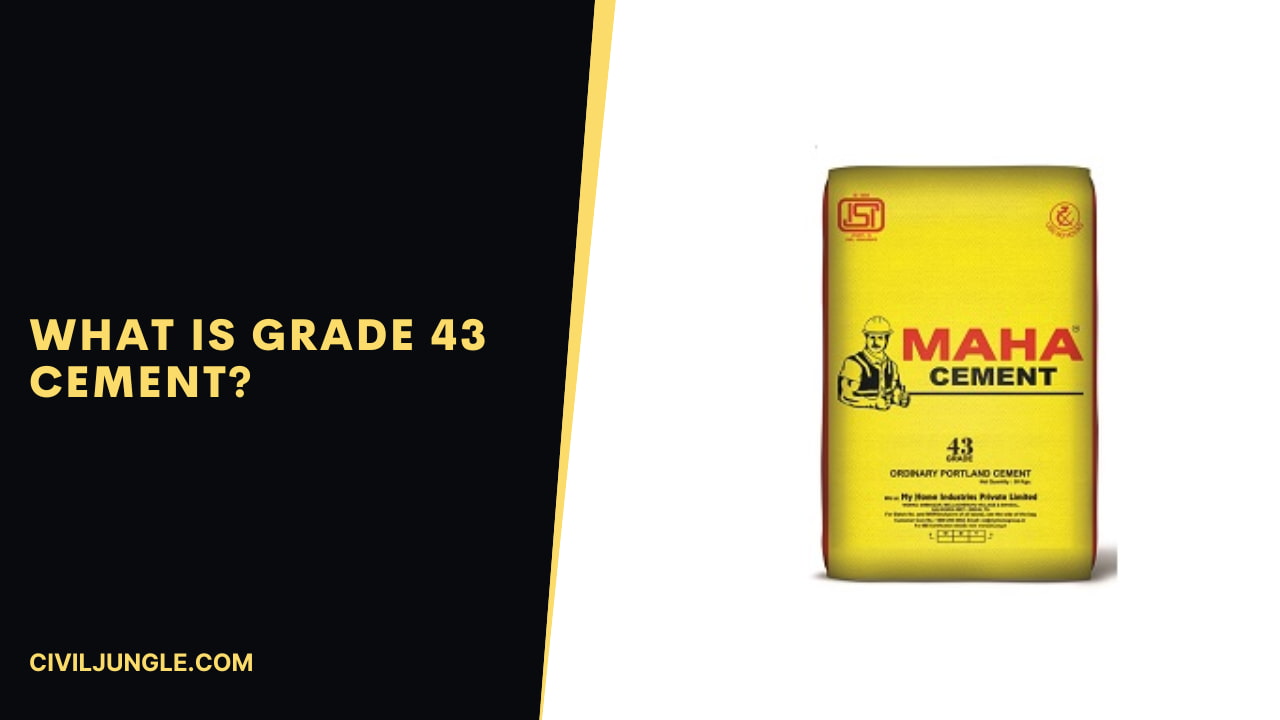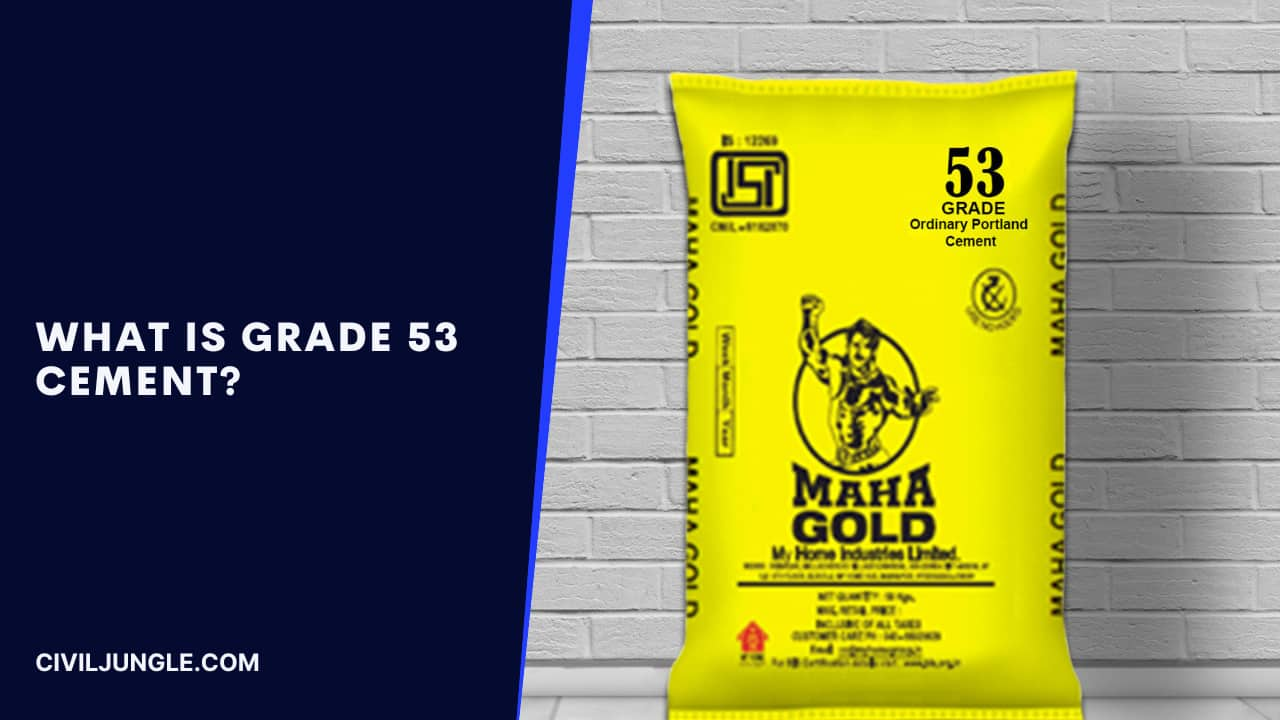The cement grades indicate how much cement has a rolling resistance. The strength of the cement (Compressive strength) was generally measured after 28 days with adequate curing.
Proper curing is very important because curing controls the rate of hydration of the cement, so proper curing is very important to obtain the total compressive strength of the cement.
Ordinary Portland cement has 3 grades 33, 43, and 53. According to the Bureau of Indian Standard, these grades are differentiated by their compressive strengths and expressed in megapascals (Mpa), which is N / mm2.
Compressive strength is a proportion of load per unit area. The load is calculated in newton (N), and the area is calculated in mm2. The differences between 33, 43, and 53 grades cement are as follows:
Generally, three different types of cement are used, which are,
- Grade-33 Cement.
- Grade-43 Cement.
- Grade-53 Cement.
Also, read: Difference Between M25 and M30 Concrete | What Is M25 Grade | What Is M30 Grade
What Is Grade 33 Cement?
Important Point
Grade 33 Portland cement shows its high workability compared to other grades. In plaster and masonry mortars, grade 33 was commonly used.
Fineness = 300 kg/m2
Crush strength 3 days later = 16 N/mm2 after 7 days later, force = 22 N/mm2 after 28 days later, force = 33 N/mm2
What Is Grade 43 Cement?
Portland Grade 43 cement was generally used in the construction of reinforced concrete, also called R.C.C. Class 43 is also used in R.M.C, which is also called pre-mixed concrete and is also used in precast concrete for construction purposes.
The fineness will be = 225 kg/m2
Crush resistance 3 days later = 23 N/mm2 after 7 days later, force = 33 N/mm2 after 28 days later, force = 43 N/mm2
Grade 43 cement has a good ability to resist sulfate, and grade 43 has a low chloride content. Class 43 cement has a good working capacity, and, using this class, we obtain a good and smooth exit surface.
Also, read: Cinder Block Vs Concrete Block | What Is Cinder Blocks | What Is Concrete Blocks
What Is Grade 53 Cement?
In grade 53, Portland cement, low chloride content was present, and grade 53 cement has a good ability to resist sulfate.
The amount of cement is required in a smaller volume because this grade has high strength as compared to other grades of Portland cement.
Grade 53 cement is mainly used in:
- Construction of Bridges.
- Construction of precast civil construction.
- Construction of factories, construction of buildings, etc. (Strength required for buildings).
- Construction of concrete sleeper (for railways).
The fineness of grade 53 will be = 225 kg/m2 Crush resistance 3 days later = 27 N/mm2 after 7 days, force = 37 N/mm2
After 28 days, force = 53 N/mm2
Grade 53 cement has high strength after 28 days after proper curing. Without proper healing, strength is not achieved properly.
Also, read: What Is Slump Cone Test | Principle of Slump Test | Types of Concrete Slump
Difference Between 33, 43 and 53 Grade Cement
1. Grade of Cement: IS Codes
- For 33 grade IS 269 is used
- For 43 grade IS 8112 is used
- For 53 grade IS 12269 is used
2. Grade of Cement: Compressive strength
For calculating the compressive strength, sand and water from the cement are mixed, vibrated and cured, and cubes are made.
These cubes are tested in the laboratory at 27 ° C after 3 days, 7, and 28 days. The cement classification indicates the compressive strength of the concrete after 28 days of laying.
| Sr. No. | Grade of Cement | Compressive Strength in 3 days | Compressive Strength in 7 days | Compressive Strength in 28 days |
| 1 | 33 grade | 16 N/mm2 | 23 N/mm2 | 27 N/mm2 |
| 2 | 43 grade | 22 N/mm2 | 33 N/mm2 | 37 N/mm2 |
| 3 | 53 grade | 33 N/mm2 | 43 N/mm2 | 53 N/mm2 |
Also, read: What Is Cover in Concrete | Clear Cover in Beams, Slab, Column, Footing
3. Grade of Cement: Initial strength
Here you can see that the initial strength of cement 53 is greater than 33grde or 43.
The strength of grade 53 does not increase much after 28 days due to the initial strength gain, while grade 33 and 43 cement continues to gain strength after 28 days.
Over time, 33 and 43-grade cement will achieve the same maximum strength as 53-grade cement.
4. Grade of Cement: Heat of Hydration
During the initial setup, the 53-grade cement releases heat of hydration at a much faster rate compared to the 33 and 43 cement.
Therefore, the chances of microcracks are much greater; these micro-cracks may not be visible on the surface. Often, site supervisors or masons increase the amount of cement in the mix.
They think this will increase the strength and durability of the concrete. But it creates micro-cracks in the concrete.
Therefore, grade 53 cement should only be used where such applications justify the manufacture of concrete with greater strength, where there are good supervision and quality assurance measures and where appropriate precautions are taken to reduce the greatest heat of hydration through an appropriate healing process.
The 43-grade cement releases medium heat of hydration. The 33-grade cement releases low heat of hydration.
Also, read: Quality Testing of Sand for Concrete | Quality Testing of Sand for Construction | Type of Sand Test
5. Price of Grade Cement
- The price of 33-grade cement is lower than 43-grade cement.
- The 43-grade cement price is higher than 33 but lower than 53.
- The price of cement 53 is higher than 33 and 43.
6. Uses of Cement Grade
Currently, 33-grade cement is rarely used. As most manufacturers have adopted PPC. 33-grade cement is commonly used to manufacture low strength concrete, as below M20 concrete.
43-grade cement is used in PCC and RCC works, preferably where the concrete grade is up to M30.
It is also recommended for plastering, tiles, masonry and stone masonry, flooring, path, etc., where the initial days are strong, and not of primary importance.
It is also used to finish all types of buildings, bridges, culverts, roads, water retention structures, etc.
Grade 53 OPC cement is recommended in all RCC structures, such as feet, columns, beams, and slabs, where initial and final strength is the main structural requirement. Can also be used for RCC jobs where the concrete grade is M30 and above
Building – Activity,
- A precast concrete item, such as paving blocks, tiles, building blocks, pipes, sleepers, masts, etc.
- Work in prestressed concrete, such as bridges, silos, etc.
- Track, concrete roads, bridges.
- Concreting for cold weather, cement grout, instant clogging, etc.
Every type of cement is suitable for a different set of tasks. Each of them has a variable level of resistance, the use of incorrect resistance levels for a specific job can affect your overall structural design.
53 Grade Cement
OPC 53 Grade cement is required to conform to BIS specification IS:12269-1987 with a designed strength for 28 days being a minimum of 53 MPa or 530 kg/cm2. 53 Grade OPC provides high strength and durability to structures because of its optimum particle size distribution and superior crystallized structure.
Difference Between 33 43 53 Grade Cement
The strength of 53 grade does not increase much after 28 days because of early strength gain. While 33 grade and 43–grade cement continue to gain strength after 28 days. With time 33 and 43–grade cement will attain the same ultimate strength as that of 53–grade cement.
Cement Grades
Generally, there are three types of cement grades; 33-grade, 43-grade, and 53-grade. Read on to know more about these types of cement that will help you decide on need.
Cement Grading
The strength gets further measured as the comprehensive strength, which is the moulded cement in the standard cube. After 28 days of curing, it gets estimated. The measurements are in Mega-Pascal or N/mm. Generally, there are three types of cement grades; 33-grade, 43-grade, and 53-grade.
53 Grade Cement
OPC 53 Grade cement is required to conform to BIS specification IS:12269-1987 with a designed strength for 28 days being a minimum of 53 MPa or 530 kg/cm2. 53 Grade OPC provides high strength and durability to structures because of its optimum particle size distribution and superior crystallized structure.
Is Cement a Plaster?
Cement plaster is a mixture of suitable plaster, sand, Portland cement and water which is normally applied to masonry interiors and exteriors to achieve a smooth surface. Walls constructed with stock bricks are normally plastered while face brick walls are not plastered.
OPC 53 Grade Cement
OPC 53 Grade cement is required to conform to BIS specification IS:12269-1987 with a designed strength for 28 days being a minimum of 53 MPa or 530 kg/cm2. 53 Grade OPC provides high strength and durability to structures because of its optimum particle size distribution and superior crystallized structure.
33 Grade Cement, 43 Grade Cement and 53 Grade Cement Price.
| Cement Grade | Min Price | Max Price |
| Grade 33 | Rs 270/Bag | Rs 370/Bag |
| Grade 43 | Rs 280/Bag | Rs 390/Bag |
| Grade 53 | Rs 262/Bag | Rs 350/Bag |
Why Is Cement So Strong?
The production of crystallisation leads to more and more calcium silicate hydrate forming and thickening until the water molecules’ path is blocked and there are no longer any empty, weak spaces in the mixture. This results in a very low porous, and therefore very strong, structure.
What Is Grade of Cement?
The cement grade refers to the cement compressive strength that means how much strength cement can yield or bear. As we all know, cement is the vital ingredient of concrete, and its strength is directly proportional to concrete strength.
Is Code of Opc 53 a Grade?
Codes for cement grades: Earlier, there used to be three IS codes for different grades of OPC. For OPC 33 grade, the IS code was IS 269 and cement bags were marked with IS 269 mark. For 43 grade OPC, the IS code was IS 8112. For 53 grade cement, IS code used to be IS 12269.
What Is Good Quality Cement?
The cement should be lump- and dust-free and feel cool to the touch, indicating no hydration reaction is taking place. Look at the color. Cement for building construction should be a uniform greenish-gray, while cement for decorative applications is white.
What Is Opc 53 Grade Cement?
OPC 53 Grade cement is required to conform to BIS specification IS:12269-1987 with a designed strength for 28 days being a minimum of 53 MPa or 530 kg/cm2. 53 Grade OPC provides high strength and durability to structures because of its optimum particle size distribution and superior crystallized structure.
What Do You Mean by Grade 33?
33 grade cement means that the compressive strength of the cement after 28 days is 33N/mm2 when tested as per Indian Standards under standard conditions. This grade of cement is used for general construction work under normal environmental condition. It may not be suitable for concrete grade above M20.
Which Cement Is Best for Plaster?
There are three main Cement Grades from which you can choose. These are Ordinary Portland Cement (OPC), Portland Slag Cement (PSC) and Portland Pozzolana Cement (PPC) available in the market. OPC is available in two grades 43 and 53. Both grades are considered best for plastering work.
Is Cement Stronger Than Plaster?
At times walls plastered with cement may develop cracks or shrinkage after a few months, but gypsum plaster remains fault-free for a longer time. It doesn’t mean it is stronger and durable than cement. When a comparison is made, gypsum plaster seems to earn more favourable points.
Is Code for OPC 43 Grade Cement?
For 43 grade OPC, the IS code was IS 8112. The cement bags carrying IS 8112 mark were presumed to be having 43 grade cement.
Can We Use PPC Cement for Slab?
Portland pozzolana cement (PPC) is used for the construction of houses, schools, and residential building slabs. PPC is cheaper than ordinary Portland cement. Thus to reduce the building making cost, PPC should be adopted. Both the PPC and OPC cement is used in the construction of slabs.
Is Cement Stronger Than Concrete?
Cement is not stronger than concrete. On its own, in fact, cement is prone to cracking. When combined with aggregate materials and water and allowed to harden, however, cement now concrete is extraordinarily strong.
What Is Meant by 43 Grade Cement?
Cement grade indicates the compression strength of the cement concrete after 28 days of setting. 43 Grade Cement attains compression strength of 43 Mpa (megapascals) in 28 days of setting compared to 53 Mpa attained by 53 Grade cement.
Which Cement Is Best for RCC Work?
53 Grade Cement is ideal for RCC works, pre-stressed concrete, and mortars because it offers higher density. Seven days after setting, 53 Grade Cement gets 27 MPa, and it’ll reach anywhere from 53 up to 70 MPa.
What Does Grade 53 Cement Indicate?
53 Grade cement is used for fast paced construction were initial strength is to be achieved quickly. 53 Grade cement has fast setting compared to 43-grade cement. 53 Grade attains 27 Mpa in 7 days compared to 23 Mpa by 43-grade cement.
How Can We Identify 53 Grade Cement?
For 53 grade cement, IS code used to be IS 12269. All cement bags having 53 grade cement carried IS 12269 mark.
What Is Meant by 33 Grade of Cement?
33 grade cement means that the compressive strength of the cement after 28 days is 33N/mm2 when tested as per Indian Standards under standard conditions. This grade of cement is used for general construction work under normal environmental condition.
Can We Use 43 Grade Cement for Slab?
Unless a project requires very high strength cement, the use of 43 Grade OPC is generally recommended in general civil construction work such as residential, commercial and industrial structures. It is used in RCC works, preferably where the grade of concrete is up to M-30.
Which Is Stronger Cement or Aggregate?
Although the terms cement and concrete are often used interchangeably, cement is actually an ingredient of concrete. Concrete is basically a mixture of aggregates and paste. The aggregates are sand and gravel or crushed stone; the paste is water and portland cement. Concrete gets stronger as it gets older.
Which Cement Is Best for Waterproofing?
Water Repellent Cement is also called Hydrophobic Cement. A small amount of Hydrophobic surfactants such as stearic acid, boric acid or oleic acid is mixed with the ordinary portland cement during grinding of clinker. Hydrophobic Cement is most suitable for basements and for making water tight concrete.
How Do I Know If My Cement Is 53 Grade?
OPC 53 Grade cement is required to conform to BIS specification IS:12269-1987 with a designed strength for 28 days being a minimum of 53 MPa or 530 kg/sq.cm.
Which Is the Best 53 Grade Cement in India?
Use of OPC 53 grade and PPC ( Portland pozzolana cement) is the best cement for roof dhalai and for all type of RCC structure like footing,slab, beam and column.
Can We Use 53 Grade Cement for Plastering?
OPC is available in two grades 43 and 53. Both grades are considered best for plastering work. However, OPC 43 Grade is most commonly used because OPC 53 Grade sometimes causes shrinkage cracks to appear. However, OPC 53 grade is more preferred due to its comprehensive strength and its long-lasting lifetime.
Which Cement Is Better 43 Grade or 53 Grade?
The fineness in cement generates early gain in strength, but along with high heat of hydration. OPC 43 grade cement is generally used for non-structural works like plastering flooring etc. Whereas OPC 53 grade cement is used in projects which require higher strength like concrete bridges, runways RCC works etc.
What Does 33 43, and 53 Grades of Cement Mean?
By the grade of cement as 33, 43, 53, the values 33, 43, 53 indicate the compressive strength of cement cube in Mpa (N/mm2) after 28 days of curing, where cement mould size is 7.06 cm x 7.06 cm x 7.06 cm.
What’s Difference Between Cement and Concrete?
Although the terms cement and concrete often are used interchangeably, cement is actually an ingredient of concrete. Concrete is a mixture of aggregates and paste. Cement comprises from 10 to 15 percent of the concrete mix, by volume.
Which Cement Is Better 33 Grade or 53 Grade and Why?
The initial strength of 53 grade cement is higher than 33 grade or 43 grade cement. The strength of 53 grades does not increase much after 28 days due to initial strength increases, while 33 grade and 43-grade cement are gaining strength even after 28 days.
What Is the Fineness Value for a OPC 53 Grade Cement?
When a 53 grade ordinary Portland cement is tested for its physical requirements, then it must satisfy the following specifications given by IS 12269. The fineness value of 53 grade OPC when tested by Blaine’s air permeability method shall not be less than 225 m2/kg.
Uses and Benefits of 33 Grade Cement
The 33 Grade signifies the type of cement with a compressive strength of 33 N/mm2. The compressive strength is measured after 28 days of construction. This cement is used for making concrete below M-20 grade. It is applied for general construction purposes.
Strength Characteristics of 43 Grade Cement
OPC 43 cement shall conform to IS:8112-1989 and the designed strength of 28 days shall be minimum 43 MPa or 430 kg/sqcm. Even though 43 Grade cements’ early strength is less as compared to that of 53 Grade, with time it will attain the same ultimate strength as that of 53 Grade cement.
Application Areas for 53 Grade Cement
As it settles down faster, the 53 Grade cement is generally applied in bigger construction projects, including dams, bridges, and flyovers.
Cost Comparison: 33 Vs 43 Vs 53 Grade Cement
The strength of the 53 grade does not increase much after 28 days because of early strength gain. While 33-grade and 43-grade cement continue to gain strength after 28 days. With time 33 and 43-grade cement will attain the same ultimate strength as that of 53-grade cement.
Uses and Advantages of 33 Grade Cement
Applications of OPC 33 Grade Cement
- It is popular in masonry work.
- It is used for making the brickwork of the walls.
- It assists in the tiling of the floors.
- It is applied in areas which require comprehensive strength below M20.
Difference Between 43 and 53 Grade Cement
OPC 43 means that the cement is expected to reach a compressive strength of 43 MPa in a cube cast by 28 days. Similarly, OPC 53 reaches 53 MPa by 28 days. There is a contrasting difference in the setting times of these cements. OPC 53 sets quicker than OPC 43 and has a quite low initial setting time.
33, 43 53 Grade Cement Difference
33/43/53 grade cement is similar in chemical composition but different in the grinding process. For the higher grades, cement is ground much finer during the final stages of the grinding work, which imparts more durability and strength to the cement. Various experimental methods are described in standard guidelines.
What Is 53 Grade Cement?
… cement means that the compressive strength of the cement after 28 days is 53 N/mm2 when tested as per Indian Standards under standard conditions
What Is 43 Grade Cement?
43 grade cement means that the compressive strength of the cement after 28 days is 43 N/mm3 when tested. This grade of cement is used for plain concrete work and plastering works. It is suitable to make concrete mix up to M30. 43 grade cement is also used to make precast items, such as tiles, blocks, pipes, etc.
How to Identify Ultratech 53 Grade Cement?
The most important point to check on a cement bag is its grade and type of cement. The cement bag of OPC 53 must mentioned the words ‘Ordinary Portland Cement, 53 Grade ‘or’ Ordinary Portland Cement, 53-S Grade whichever is applicable.
Types of Cement Grades
Generally, there are three grades of cement available in the market. Cement is available in 33 grade, 43 grade and 53 grade. The grade of cement is generally differentiated in terms of indicates the strength of cement. The strength of cement is generally measured as compressive strength.
Different Types of Concrete Grades
Concrete grades include; C7/8 Concrete, C10 Concrete, C15 Concrete, C20 Concrete, C25 Concrete, C30 Concrete, C35 Concrete and C40 Concrete.
Opc Cement Uses
Its uses include pavements and sidewalks, reinforced concrete buildings, bridges, railway structures, tanks, reservoirs, culverts, sewers, water pipes and masonry units.
Like this post? Share it with your friends!
Suggested Read –
- Cement Manufacturer
- Plastering and Pointing
- Building Estimation Step by Step In Excel Sheet
- Concrete Material Calculation / Concrete Quantity
- Heartwood Vs Sapwood | What Is Sapwood | What Is Heartwood
- M30 Grade of Concrete Mix Design Procedure with OPC 53 Cement
- What Is DLC (Dry Lean Concrete) | Advantage of DLC (Dry Lean Concrete )
- Detail of Beam Connection | Simple Framing Connection | Semi-Rigid Framing Connection | Rigid Frame Connection





Great content! Super high-quality! Keep it up! 🙂
I’m extremely impressed with your writing skills and also with the layout on your blog. Is this a paid theme or did you modify it yourself? Anyway keep up the nice quality writing, it’s rare to see a nice blog like this one today..
This Theme Paid
Excellent write-up. However, a minor correction is needed. Fineness is expressed in m2/Kg.
The article is worth my time. Good work but if I could find a pdf for this would be much greater